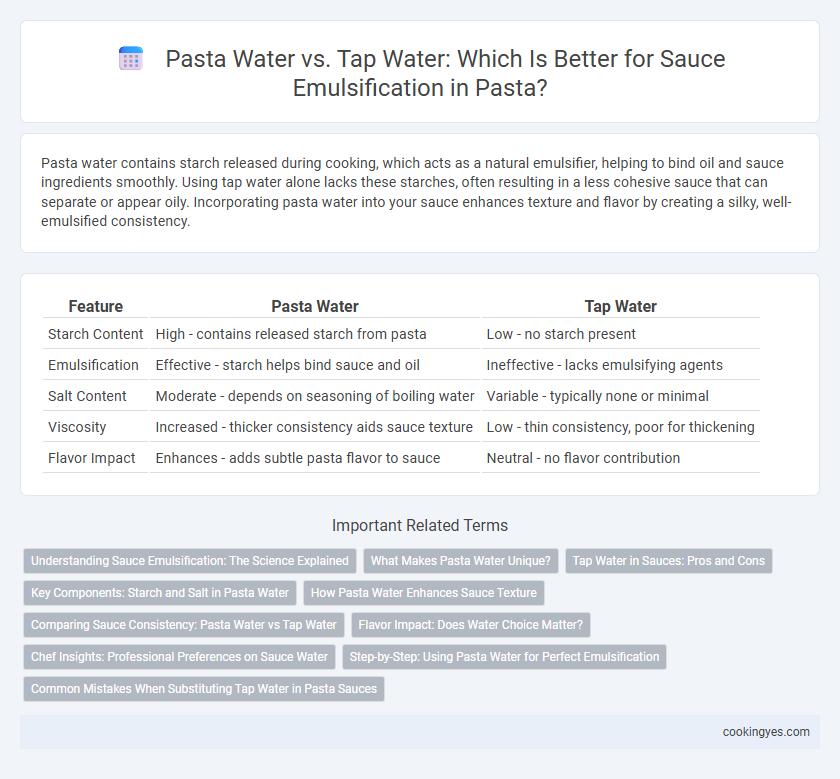Pasta water contains starch released during cooking, which acts as a natural emulsifier, helping to bind oil and sauce ingredients smoothly. Using tap water alone lacks these starches, often resulting in a less cohesive sauce that can separate or appear oily. Incorporating pasta water into your sauce enhances texture and flavor by creating a silky, well-emulsified consistency.
Table of Comparison
| Feature | Pasta Water | Tap Water |
|---|---|---|
| Starch Content | High - contains released starch from pasta | Low - no starch present |
| Emulsification | Effective - starch helps bind sauce and oil | Ineffective - lacks emulsifying agents |
| Salt Content | Moderate - depends on seasoning of boiling water | Variable - typically none or minimal |
| Viscosity | Increased - thicker consistency aids sauce texture | Low - thin consistency, poor for thickening |
| Flavor Impact | Enhances - adds subtle pasta flavor to sauce | Neutral - no flavor contribution |
Understanding Sauce Emulsification: The Science Explained
Pasta water contains starch released during cooking, which acts as a natural emulsifier, binding oil and water molecules to create a smooth, cohesive sauce. Tap water lacks these starches, making it less effective for achieving the creamy texture essential in emulsified sauces. Incorporating pasta water enhances sauce stability and flavor integration by balancing the sauce's viscosity and preventing separation.
What Makes Pasta Water Unique?
Pasta water contains starch released during cooking, acting as a natural thickening agent that enhances sauce emulsification and texture. The starch molecules in pasta water bind with fats in the sauce, creating a creamy, cohesive consistency that tap water cannot replicate. Unlike tap water, pasta water's unique composition improves sauce adhesion to pasta for superior flavor integration.
Tap Water in Sauces: Pros and Cons
Tap water contains minerals like calcium and magnesium that can interfere with sauce emulsification, leading to less stable and separated sauces. Its variable hardness and chlorine levels may affect the flavor and texture of delicate sauces, especially those relying on starch-protein interactions. Unlike pasta water, which is rich in starch aiding emulsification, tap water lacks these properties, making it a less effective choice for enriching and thickening pasta sauces.
Key Components: Starch and Salt in Pasta Water
Pasta water contains essential starch and salt released during cooking, which act as natural emulsifiers, helping to bind and thicken sauces more effectively than tap water. The starch granules increase the sauce's viscosity, creating a smooth, glossy texture, while the salt enhances flavor integration and balances seasoning. Using reserved pasta water elevates sauce consistency and taste, making it a critical component for perfect emulsification.
How Pasta Water Enhances Sauce Texture
Pasta water contains starch released during cooking, which acts as a natural emulsifier to thicken and bind sauce ingredients, creating a creamy, velvety texture. The saline content in pasta water also helps season the sauce evenly, enhancing overall flavor integration. Unlike tap water, pasta water improves the sauce's consistency and adhesion to the pasta, ensuring a more cohesive dish.
Comparing Sauce Consistency: Pasta Water vs Tap Water
Pasta water contains starch released from the pasta during cooking, which acts as a natural emulsifier, improving sauce consistency by creating a smoother, creamier texture that adheres better to the noodles. Tap water lacks these starches and often results in a thinner, less cohesive sauce that can separate or fail to cling properly. Using pasta water enhances sauce viscosity and stability, making it essential for achieving a well-emulsified, restaurant-quality finish.
Flavor Impact: Does Water Choice Matter?
Using pasta water instead of tap water enhances sauce emulsification due to its starch content, which helps bind and thicken the sauce, creating a silkier texture. The residual salt and starch in pasta water contribute to a more balanced, savory flavor profile compared to plain tap water, which lacks these elements. This difference significantly impacts the overall taste and mouthfeel, making pasta water the preferred choice for a richer, well-integrated sauce.
Chef Insights: Professional Preferences on Sauce Water
Chefs prefer pasta water over tap water for sauce emulsification due to its high starch content, which enhances sauce texture and helps it cling better to pasta. The natural starches released during cooking create a velvety consistency, allowing for smoother integration of oil or butter in the sauce. Using pasta water also aids in balancing the sauce's thickness, preventing it from being too watery or too heavy.
Step-by-Step: Using Pasta Water for Perfect Emulsification
Reserve about one cup of pasta water before draining to capture the starchy liquid essential for sauce emulsification. Gradually add the pasta water to your sauce while stirring vigorously to create a smooth, cohesive texture that clings to the pasta. The starches in pasta water act as a natural thickener and binder, enhancing the sauce's creaminess compared to regular tap water.
Common Mistakes When Substituting Tap Water in Pasta Sauces
Using tap water instead of reserved pasta water for sauce emulsification often leads to a loss of starch content essential for proper sauce binding and texture. Tap water lacks the fine starch particles released by pasta during cooking, resulting in sauces that are thin, gritty, or prone to separation. Common mistakes include ignoring the starch concentration in pasta water and failing to adjust seasoning, which compromises sauce consistency and flavor integration.
Pasta water vs Tap water for sauce emulsification Infographic

 cookingyes.com
cookingyes.com